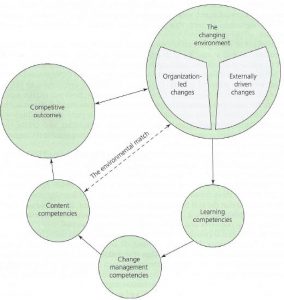
Elements of Strategic Interdependent Competencies:
- Strategic awareness and learning
- Failure and crisis avoidance
- Avoid business failure
- Plan for things going wrong
- Manage business and other crises
- Manage turnarounds
- Stakeholder satisfaction
- Understand and meet needs
- Satisfy key succes factors (KSF)
- Ethics and social responsibility
- Manage green issues
- Manage socially
- Manage ethically
- Strategic awareness and control
- Think strategically
- Environmental awareness
- Self-enacted reality avoidance
- Fitting organization
- Failure and crisis avoidance
- Process change
- Strategic awareness and control
- Self-enacted reality avoidance
- Fitting organization
- Quality and customer care
- Quality
- Continuous improvement
- Innovative and creative organisations
- Strategy implementation
- Ability to operationalize
- New competitive paradigms
- Internal synergy
- Empowerment
- Flexible plans
- Winning vision
- Strategic collaboration
- Strategic awareness and control
- Content competencies
- Strategy implementation
- Flexible plans
- Winning vision
- Strategic collaboration
- Functional compentencies
- Effective distribution
- Harness IT
- Financial control
- Research & Development
- Develop Human Resources
- Develop new processes
- Develop new products
- Competitive strategy
- Stay close to customers and choose winning product
- Understand competitive situations
- Strategy implementation
Principle:
Layers of strategic competence
The eight theme groups (inner circle) are needed, strategic leader must identify which of the 32 that can really make a difference
Issues:
Change comes from learning by understanding
Learning comes from all stakeholders
– Managers must share information, work in harmony and create synergy
The three groups of Strategic Groups of Competencies

Content competencies add value, innovate and exploit core competences (technology) and strategic capabilities (process)
Change competencies enables the organization to adapt to a dynamic environment
Learning competencies enables the organization to understand the environment, customers and competitors
Applications:
Manage portfolio of strategic competencies
Source of Strategic Interdependent Competencies:
(Thompson & Martin, 2005)






